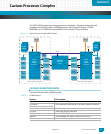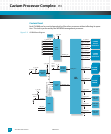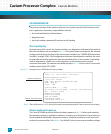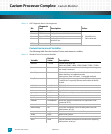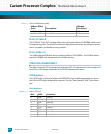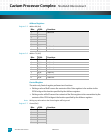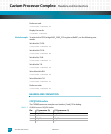
Cavium Processor Complex: Memory
10009109-01 ATCA-9305 User’s Manual
3-9
MEMORY
The processor complex supports DDR2 Synchronous DRAM (SDRAM) and Reduced Latency
DRAM (RLDRAM) memory devices.
DDR2 SDRAM
The ATCA-9305 supports up to 16 gigabytes of 144-bit wide DDR2 SDRAM per processor
complex. The SDRAM interface clock speed frequency is 400 MHz. The four low-profile,
dual-inline memory modules (buffered DIMM) are installed in 240-pin very low profile (VLP)
sockets to reduce board density and routing constraints. A 2 KB EEPROM on the DIMM pro-
vides the serial presence detection (SPD). On-card SDRAM occupies physical addresses
from 0,0000,0000,0000
16
to 0,0003,FFFF,FFFF
16
.
Each processor memory bus is operating in 144-bit mode. Error-correcting Code (ECC) is
performed on the memory bus so that the CN5860 detects all double-bit errors, multi-bit
errors within a nibble, and corrects all single-bit errors.
RLDRAM
Each CN5860 supports 256 MB Common I/O (CIO) RLDRAM operating up to 400 MHz
(depends on the processor speed). The Micron RLDRAM II is organized as 32Mx18x8 internal
banks. The DDR I/O interface transfers two data words per clock cycle. Output data is refer-
enced to the free-running output data clock. Read and write accesses to the RLDRAM are
burst-oriented. RLDRAM is accessed by using Cavium-specific instructions which operate on
MIPS Coprocessor 2.
I
2
C EEPROM
Each Cavium processor complex has one user EEPROM device for parameter storage located
on the I
2
C bus, address 0xA8. The I
2
C bus for each processor is completely independent
from the other CN5860 processor and MPC8548 processor I
2
C buses. The Atmel two-wire
serial EEPROM on each CN5860 processor I
2
C interface consists of the Serial Clock (SCL)
input and the Serial Data (SDA) bidirectional lines.
stdin serial Sets the standard source for console input
Valid options: serial, pci
stdout serial Sets the standard destination for console output
Valid options: serial, pci
Variable:
Default
Value: Description: (continued)



